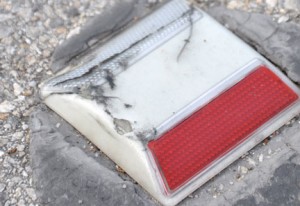 The worst of driving conditions calls for the best of roadway markers. And with their reflective properties, retroreflective raised pavement markers (RRPMs) have guided many nervous drivers safely to their destination on rainy nights. That’s why RRPMs‘ durability and performance are of critical importance to the Texas Department of Transportation (TxDOT).
The worst of driving conditions calls for the best of roadway markers. And with their reflective properties, retroreflective raised pavement markers (RRPMs) have guided many nervous drivers safely to their destination on rainy nights. That’s why RRPMs‘ durability and performance are of critical importance to the Texas Department of Transportation (TxDOT).
A few years ago, though, TxDOT began to notice an increased number of RRPM failures such as poor retention on pavements, physical damage and loss of retroreflectivity. In some cases, mass failures occurred when an entire section of RRPMs disappeared only weeks after installation. In response to this problem, the Texas Transportation Institute (TTI) began to research the causes of premature RRPM failures.
“All the markers that TxDOT was using met the requirements set by ASTM specifications,” says Yunlong Zhang, TTI assistant research scientist and research supervisor “However, RRPMs‘ performance varied significantly, and the results from existing testing methods also did not correlate with field performance. We were asked to identify or develop new lab testing methods that would help us to more accurately predict marker performance in the field.”
Over a three-year period, researchers conducted multiple tasks that included lab and field tests, as well as surveying TxDOT districts and RRPM manufacturers to gather information on existing test procedures and marker field performance.
“For two years we monitored four test deck locations that were selected based on traffic condition and pavement type,” says Zhang. “For example, one of our test decks was on the 610 Loop in Houston, which is a very high-volume concrete roadway. We also had a test deck on a low-volume road with a flexible pavement surface. The goal was to get a wide range of test data in different scenarios.”

The research yielded several important findings with respect to RRPM performance and testing methods:
- Performance of RRPM products has a wide range and depends on traffic volume, truck traffic and pavement surface type.
- Retroflectivity degrading is directly related to average daily traffic.
- High truck traffic significantly accelerates marker physical damage.
- Marker retention is directly related to installation quality.
- Current testing methods were inadequate and cannot predict field performance of the markers.
Another important finding was that the results from the developed pendulum impact test (see below) had a sound correlation with that of field performance, giving TxDOT a proven marker quality-control tool.
“RRPM failures are not only a public safety issue, but also expensive when you take into consideration having to close the roads for repairs,” says Zhang. “With the results of this research, we were able to recommend that TxDOT emphasize the quality of RRPM installation since we found it directly relates to performance in the field. And TxDOT is also now able to better predict the life expectancy of these markers for all types of roadways and traffic volumes.”
“The researchers did a great job of modeling the forces on a pavement marker from vehicular impact. This was cutting-edge work,” said Darren Hazlett, with the Construction Division at TxDOT and project director. “They also produced a pendulum impact test that could be used to test markers and have transferred this test equipment to us.”
Pendulum Impact Test
 During the project, the team discovered that many of the failures of retroreflective raised pavement markers (RRPMs) began with the fracture of the outside shell. These failures could be caused by something as simple as a stone wedged in the tire tread of a vehicle. Consequently, failure occurred due to the impact of a hard small object with the surface of the RRPM.
During the project, the team discovered that many of the failures of retroreflective raised pavement markers (RRPMs) began with the fracture of the outside shell. These failures could be caused by something as simple as a stone wedged in the tire tread of a vehicle. Consequently, failure occurred due to the impact of a hard small object with the surface of the RRPM.
“What we needed was a testing procedure that evaluated the ability of the RRPMs to absorb energy-of-impact type loading,” says Yunlong Zhang, research supervisor. “Since there was nothing that existed, we designed and fabricated the pendulum impact test device.”
The pendulum impact device is a nifty piece of equipment that allows users to test the durability of the RRPM outer shell using different weights. The RRPM is clipped into place, and a weighted arm swings down and impacts the marker. Different weights can be added to the end of the pendulum arm to increase the force exerted on the marker at impact. The marker support is adjustable, so four different impact points can be tested to give a full evaluation.
“We tested six RRPMs with this device using all six weight configurations at each of the four impact positions,” says Zhang. “Using this device to test markers before they are installed will give TxDOT a better idea of the durability and performance they can expect, particularly in high-traffic areas.”
